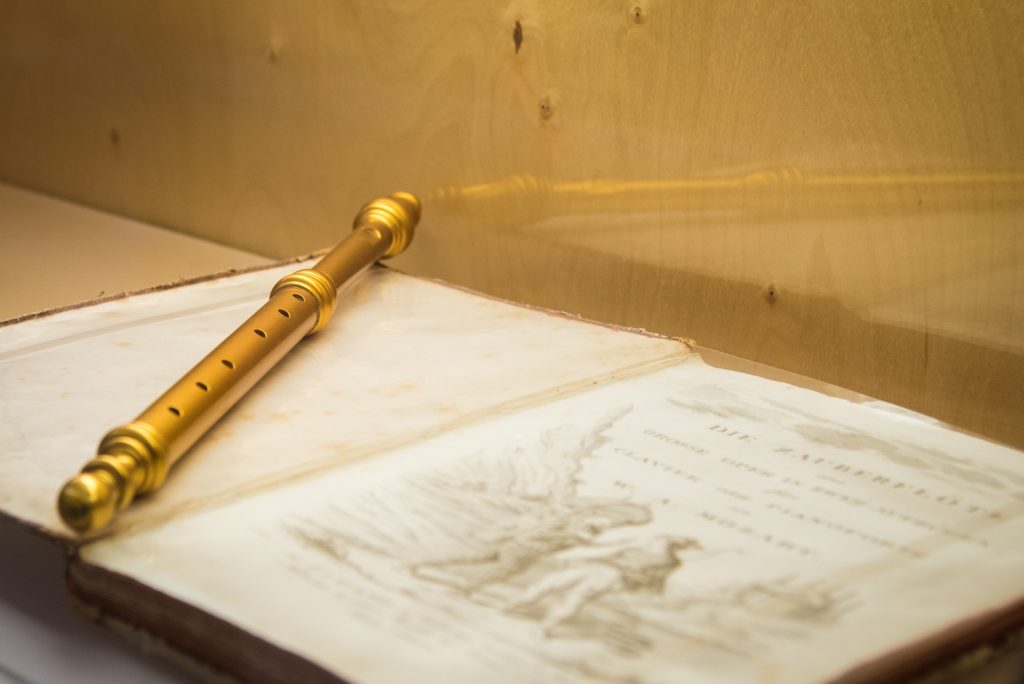Learn Flute Podcast SHOW NOTES:
In this episode, you will learn about the enchanting history of the flute.
This is the Learn Flute Podcast Episode 118.
- Information on this podcast is supplemental to LearnFluteOnline.com
- Different stages of history for the flute.
- How flutes have changed over the years.
- Rebecca’s flute-history.
- Gaining an understanding of the importance of, and an appreciation for, past flutes.
Learn Flute Podcast 118
Press the Play Button to Listen Now:
Podcast Transcript
The instrument flute has changed quite a bit over time. In fact, the oldest ones found have been made of bone. The tibia being a favorite… Ew. Well, that’s okay, today we’re going to learn some important points in the enchanting history of the flute. Let’s goooo!
Well hey there, it’s me Rebecca the expert and instructor of the Learn Flute Online programs where we are having a great time learning how to play flute and becoming better people all at the same time… you just can’t help it.
As we learn to improve our musical selves, we also find ourselves with more drive and resilience to do and be better.
These life skills are helping make a better world, so I thank you for it. You are awesome!
You know, this month in the members area of Learn Flute Online we’ve been going through a series of exciting skills challenges and we can’t wait to show everyone what we’ve created this month.
It’s going to be really fun!
We’re incorporating scales and skills to create a harmonizing and happy flute choir piece that you will not be able to resist smiling as you hear it.
We love playing together as a group, and if you haven’t had a chance yet, you really should join us because, with each step along the way here, we’re improving and connecting with music, life, and each other on a deeper level that makes, well, it makes life so much more meaningful and we invite you!
We like to say that we are the best and most friendly group of fluties you’ll ever meet!
My History
You know, when I was younger, my best friends were the ones I had something in common with.
I had a couple of friends that were so much fun. Now, I grew up way out in the boonies on a farm, and when I was finally old enough to go to the big city, to Junior High, it was a really big deal because I got to go to school in the big city about an hour’s bus-ride away. Well, not really a very big city, but to me it was. And it was so much fun for me to have even more friends.
I didn’t really feel like a new kid because I had sports and hobbies I was already involved in – it was just so natural to just drop right into these new friend groups, and one of them was playing in the band.
I made really good friends super quickly.
It was exciting and new, and one of the best things that my group of friends and I used to do, one thing that I thought was really fun, was we would get together after school, and we would take our flutes and we would play duets, and then go outside and practice for the pentathalon. It was a sporting event kind of like a triathlon except with 5 events.
I was sporty and fast so it was super fun for me. So Yah, we played flute together, and we practiced sports together… and I loved it! I’m not sure if anyone knew how much I really enjoyed these times.
It was also obvious that those of us who got together outside of school to play music together were also the top players in the band… it really only took a bit of extra playing to rise above.
We talked about flute a lot and explored how to improve together. And I loved it!
I do attribute the flute to all sorts of friendships I’ve had over my entire lifetime.
Flute History
Now, my history is nice to reflect on, but when you dive into the history of the instrument flute itself, you find that it’s quite interesting.
It’s such an emotional instrument as you know, and even though it’s beginning was just a hollow tube that a player would blow through, creating sound and the feeling of the tube vibrating still stirs your soul. No matter the shape, or what type of flute it is.
Now flutes over time have definitely changed. And there are still so many traditional flutes in the world. And they are extremely popular in certain countries – for example the traditional flutes of India are very alive and well in that country.
What we’re going to do today is take a peek into how this basic pipe changed into the complex and absolutely drop-dead-gorgeous instrument that the concert flute is today.
Now, let’s talk about the different types here for a second.
The recorder is a type of a flute also, but it is vertical where the player blows the air directly through the mouthpiece of it. Whereas the concert flute is considered a transverse flute which means it is held horizontally, to the side of the body. And also blown across instead of directly into.
The First Flutes
An interesting note is that the first flutes were also made of bone many thousands of years ago… With animal bones and human bones both. They drilled holes in the bones, or carved, so there was a nice variety of pitches that could be played on it… Even full scales – they were quite inventive.
I have always found old and traditional types of flute fascinating.
In fact, I like to collect flutes from around the world.
Do you?
I have a collection in my closet – haha I’m not really quite sure what to do with all of them, but I think one day I could open a little museum.
I have flutes from places in South America, and Europe, and China. And a few other places destinations.
The question is, do I know how to play them all? Um.. kind of and sort of and not really.
I like to dabble on them but haven’t ever made it a serious type of practice in my life except for the Irish whistles. I really like the whistles. I am pretty decent on the pan flutes as well.
One of these days, maybe even today, I’ll have to play for you.
The Middle Ages
Back in the Middle Ages, the flutes were more primitive but they changed over time as musicians and flutists were hired to live and play in royal courts of theirs and neighboring countries or provinces.
The professional flutists were incredible performers and were very much like jazz musicians of today.
As far as we can tell, flutes close to what we call the concert flute today, they were introduced into Germany around the years of one thousand AD and possibly had found its way overseas from the orient. In fact, for many years the flute that was played in the transverse position (you know, to the side of the body) was called the German Flute… I haven’t ever had anyone refer to it in this manner to me, that I know of anyway. But maybe that’s because I live in the United States, and perhaps if you live somewhere else in the world this could be still something you’d hear.
Flutes of different sizes were oftentimes used in military campaigns along with the drums because they are the instruments that have the sound that carries really far out in the fields. The flutes are higher in octave and could be heard over the sounds of the battle fields. If you’ve ever played the piccolo, you know what I’m talking about. The sound can be quite piercing and definitely carries in the wind.
In the sixteen hundreds, instrument makers began getting inventive and they started making changes to the basic construction of the flute. Before this time it had just stayed a tube with carved-out holes. But, then someone in the Netherlands had a bright idea to make the tube bigger in diameter.
Now this tube is called the bore. Once the tube or the bore was bigger in diameter, what happened to the sound was that it became more mellow instead of thin and piercing.
Also, this was about the time that the flute was cut into three pieces to make it easier to travel with, and a couple other reasons. I love it!
Then a super important thing happened, and the flute makers of the time began to pay even more attention to how finger reach and fingerings were set on the flute, and if the holes were made to be smaller or set in different places on the bore, that more finger combinations could be used without having to move the hands on the tube.
This is kind of the beginning of modern day concert flute invention ideas.
It became a trendy and in-fashion thing to practice and play music together in homes of, I would say, more cultured people.
This was known as “consort music”. So if you ever hear this term again, you’ll have an inkling of what it is.
Louis the fourteenth of france was, we could say, a super fan of the flute, and really aided in its popularity at the time. It was an instrument that was romantic and so sweet sounding…. This was the style of so much art at that time, and music.
As the sixteen hundreds moved along, the flute became more and more often played as a solo instrument.
This was really cool, and it was a very emerging time for flutists.
Before then, the flute was just part of the group, but now it was rising above to be the soloist of the group, and the other instruments were more of accompaniment, or playing along with.
The players were really quite fabulous and as I mentioned a minute ago, they were kind of similar to a jazz player of our day and age.. Not in the style of music, but in the way that they were creating music on the fly during that time, and putting so much new personality into it – it became very very popular!
Some of the composers of those days that were creating flute specific music were: Vivaldi, Bach, Handel, Telemann, and Blavet.
Traveling performers became really famous and put a spotlight on the flute. Some performers like the name of JJ Quantz was not only a performer, but also a flute composer himself. And he created some of the most cherished flute pieces still known today. He was a flutist, writing for flute.
Now this is important because if you’ve ever tried to practice and polish a work created for violin or piano, you’ll probably have noticed that they really aren’t spaced well enough for a flute player. Because, we need to breathe!
In the mid seventeen hundreds, London instrument makers realized that we could do better. They again increased the tapering of the bore, the size of the bore, and also added some keys for better reachability and again, more precise tuning and notes.
Look up the Baroque flute and check out what it looks like if you are not familiar so far. But, these makers didn’t stop here, keys were being reinvented and changed every few years as the flute went through a rapid journey or a change in many different countries.

Photo by Gianluca Carenza
There were design variations, and they were very prevalent in countries all around the world, especially like Austria, England, America, France, and Germany just as some main examples.
The Nineteenth Century
Now, in the nineteenth century, a man by the name of Theobald Boehm (this is important), he was from Bavaria in the country of Germany.
He began to invent a key system that used rods and springs and different things that were interlocked with one another.
This allowed a player to for example, press one key yet have another also move at the same time.
This helped natural hand position be used, which if you’ve listened to me in the lessons at Learn Flute Online, you can note that natural hand position equals faster action, right?
So I think the musicians were probably really excited about this invention at the time.
This Boehm style flute eventually spread throughout the world and is what all modern flute innovations are based on. It became the norm.
We have seen smaller changes over the more recent years, but I’d say that one of the biggest changes came in the nineteen sixties, that’s kind of recent, isn’t it, by an English flute maker named Albert Cooper.
This flute was rescaled, meaning everything, all of the holes and things were rescaled and moved to different positions, so the tuning is set at A=400 hz.
This is actually considered the standard pitch that the world has adopted since then.
We can talk more about this another day, in fact I think we have before, haven’t we?
It’s really quite interesting. The flute head joint is a new size and more tunable to other instruments nowadays. Nice!
The flute is used in many genres of music – what comes to mind for you? Classical? Of course. Jazz? For sure. What about folk and pop? Yep. Definitely.
There are also many famous flute players and more and more popping up every day. In short, the flute is a super cool instrument, and as each year passes, more and more creativity is used to bring it into the ears and hearts of people around the globe.
Many film scores use string orchestras to demonstrate a bleeding heart sound, but once the flute is introduced, a new level of emotion is found. It’s feathery and light, with more sweetness and tenderness as well.
So, we have come a loooong way since the days of carving out the enemy’s leg bone and creating a flute from it. Haha, thank goodness!
Flutes are made of so many different materials nowadays as well. Nickel, silver, gold, platnum and specialized woods are used to create unique sounds and resonance. I like them all.
In fact, if you ever get a chance to try flutes of different makes and materials, you should.
It’s really quite fun.
Some of the newest inventions that are becoming quite normal to find on a flute are found in the mechanism – the trill keys being the first, but even more recently a new trill key has popped up – and I quite like it. It’s the C# trill. It really aids in the B to C# fingering which used to be a bit awkward, but still do-able.
We have new roller bars, especially at the bottom of the flute which helps our pinky become sort of like a super hero. It is responsible for helping play like 5 different notes alone!
I won’t really go into much more detail of the most modern inventions because we’re going to save that for another day – because each one deserves a spotlight of its own.
Well, I hope the next time you get your flute out of its case, you take a moment to stare at it and marvel at its origin, and the journey it’s been on to get to where it is now. I doubt that flutes in a hundred years from now will be exactly as they are today though.
Invention and creativity are just exploding in today’s world.. And I can’t wait to see what happens in the music industry for the flute.
We humans like to try to make things better. So, I like to say, where there’s a will, there’s a way.
And speaking of wills and ways, I want to let you know that I’m proud of you and all you’re doing.
Just the fact that you are here today and that you stayed on until the end of this episode lets me know that you’re actively participating in your own education. You’re moving right along, and growing a bit more daily.
So thanks for being here. I really do appreciate you. I created Learn Flute Online for you. So you can come and learn to play the flute in a timely manner – and as well as possible.
Ohhh the possibilities – we’re going to keep having so much fun!
It’s the start of warmer weather where I live and I can’t wait to attend some outdoor concerts and enjoy life, family, and friends even more.
I wish you good luck on your adventures this week. I hope to see you in the members area at Learn Flute Online very soon – the lessons are waiting for you. Remember that they are in sequential order and they hold the keys to beautiful flute playing and technique.. Beside all of the melodies and friendly fun we have.
Okay, I’m going to play you out now on one of my traditional instruments… the pan flute from Peru where I literally purchased this from a performer on stage. He was up there playing and after the show, I asked him where I could get a flute just like his. He handed it right to me and I took it home!
Love it!
So now is the perfect time to bring it out for you since we’ve been talking all about the enchanting history of the flute. Let’s chat again in the next episode.
See you soon! I’m Rebecca Fuller – over and out.
Thank you for Tuning In!
Please consider subscribing and taking a minute to leave a review and rating for the podcast on iTunes.
I hope you’ve enjoyed learning about the enchanting history of the flute. Join us for the next episode.








